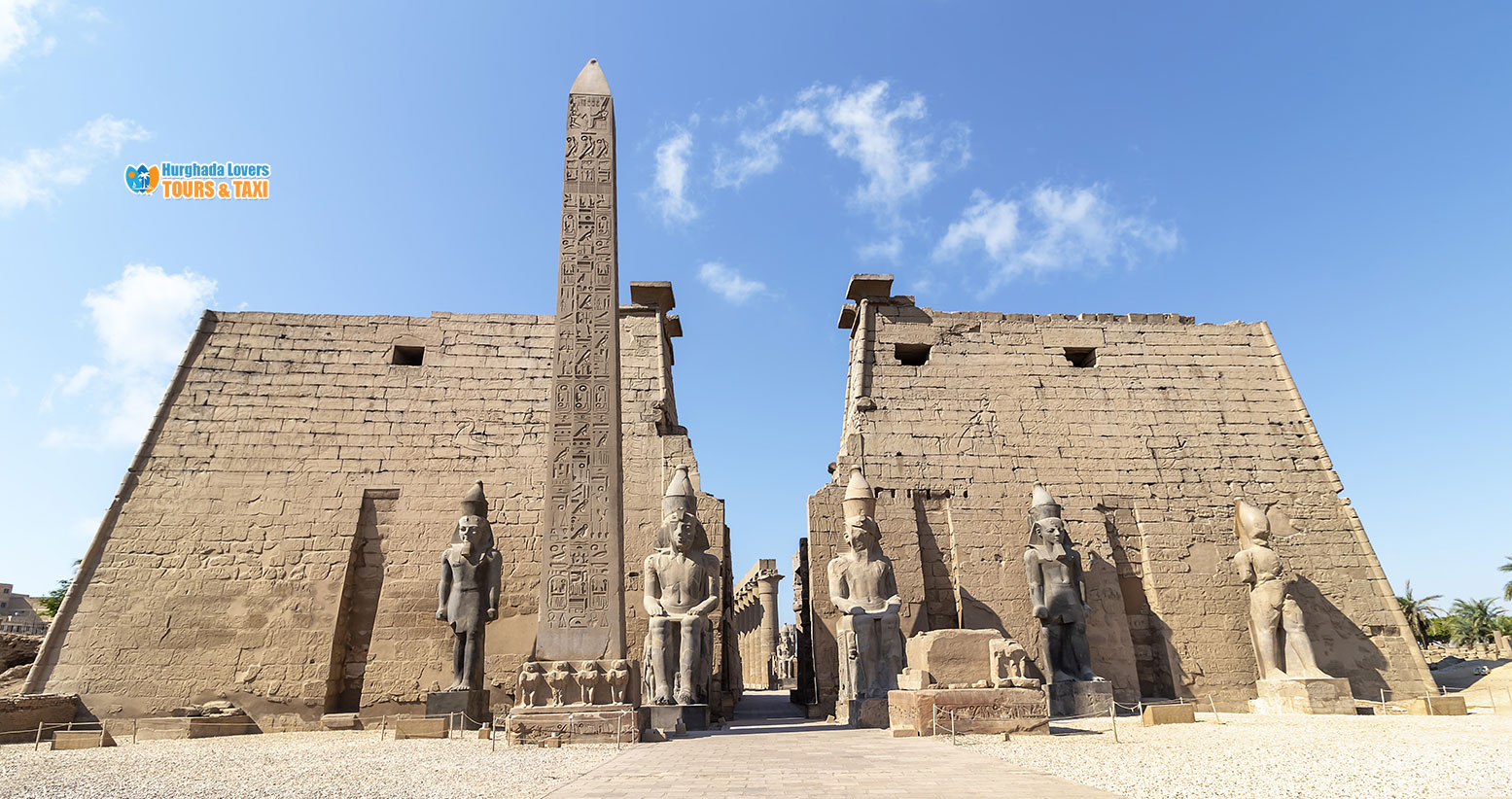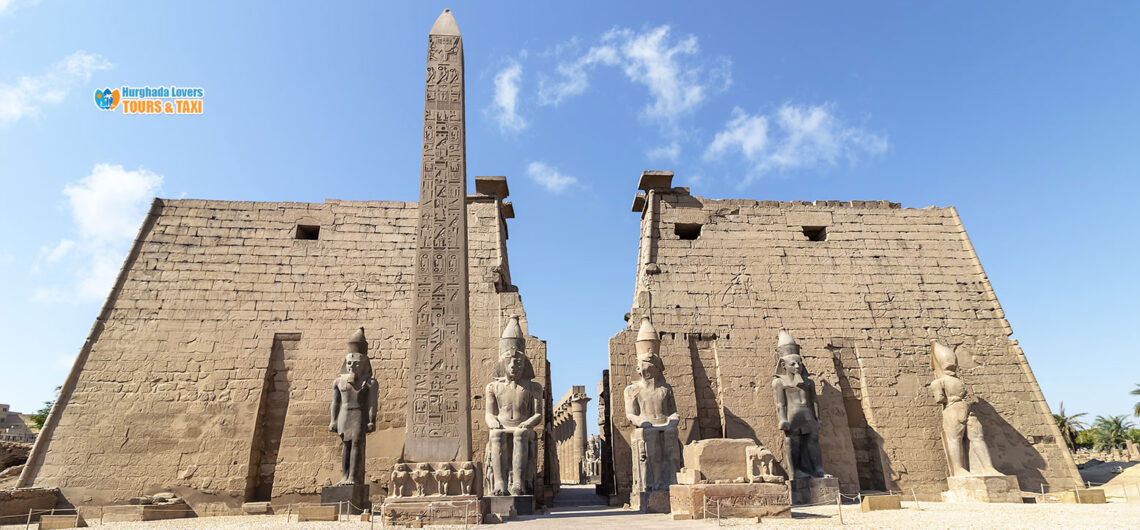Obelisks of Pharaohs | List of Pharaonic obelisks inside and outside Egypt | Discover Facts, History How old are the obelisks? What was the purpose of Egyptian obelisks, How did they carve, transport, their relationship to Egyptian Mythology.
Facts and history of the secret The pharaonic obelisks are erected in front of the temples in the ancient Egypt, how the obelisk was built and transported, what is the reason for the construction and more Ancient Egypt History.
Obelisks of Pharaohs
How old are the obelisks in Egypt?
The interest of the Egyptian Pharaohs kings in carving Pharaonic obelisks from pink and Red Granite, “the most famous Ancient Egyptian Metallurgy” began to appear beginning with the rule of king Userkaf of the Fifth Dynasty of Egypt in the period of the Old Kingdom of Egypt, where the worship of the God Ra, the most famous ancient Egyptian deities, was widespread in all regions of Upper and Lower Egypt, according to Geography of ancient Egypt.
What was the purpose of Egyptian obelisks?
- The city of Heliopolis was the capital of the Old Kingdom and was known as the city of On “Aiono”, as it was famous for building funerary Mortuary Temples “sun temples” for offering sacrifices and worshiping the god Ra, the symbol of the sun for the ancient Egyptians, as in the Ancient Egyptian religion.
- It is clear that the goal of carving the obelisk is a religious goal, in order to get closer to the god Ra, “the symbol of the sun,” in the city of Heliopolis, which is the city of the sun. It is natural for the obelisk to be carved as a symbol of the sun, “the god Ra,” and the design of the obelisk was in a vertical shape with a pointed tip. It goes up and ends with a small pyramid relative to the shape of the sun’s ray coming to the ground, which indicates the development of Astronomy in ancient Egypt and Ancient Egyptian science.
What is the geometry of an obelisk?
- A square or rectangular stone base, with monkeys carved on the sides, clapping and cheering for the sun at sunrise every morning..
- A vertical stone block carved and decorated with the names and titles of the king and texts honoring the god Ra. There is a design on 4 sides and designs on only two sides, “double-sided.””.
- A small, pointed pyramid coated with electron metal to protect the front of the obelisk from corrosion, or with gold to reflect the sun’s rays to illuminate the corners of the Sun Temple or the funerary temple. The end of the obelisk was carved on the basis of religious beliefs, as it goes back to the belief that the god Ra, the creator of the universe, appeared from the sacred waters standing on the pyramid. The eternal “Ben Ben” as in the religion of the ancient Egyptian Pharaohs.
- Pharaonic obelisks were carved from granite stones (belonging to the kings of the Pharaohs only) and wood to be placed in front of the royal Egyptian Tombs or the tombs of the nobles and high priests in power in ancient Egypt “High Priest of Amun“, where an obelisk made of wood was discovered in front of the tomb of Minister Sechemnefer within the ancient tombs of Giza..
What are some interesting facts about obelisks?
- The period of carving and decorating the obelisk takes at least 8 months.
- Sed festival the most famous Pharaonic Festivals in Ancient Egypt, was linked to the ceremony of installing the obelisk in front of the temple, where the date of the king’s inauguration, his obtaining the Coronation of the Pharaohs, the completion of his rule on the throne of Egypt for 30 years, and that he completed the tasks assigned to him by the Egyptian gods were mentioned on it. Where the king wore the double crown to indicate his control over the regions of Upper and Lower Egypt, and the clothes of ancient Egypt were designated for celebration, to run in the temple square to renew his activity and show the extent of his strength and vitality in front of his people..
- Only 3 sides of the obelisk were decorated while it was in its quarry. Then the texts were written in Ancient Egyptian Language hieroglyphics after they were installed in the temple. Sometimes the fourth side was decorated directly before it was transported to the boat in the Nile River. “The fourth side was rarely decorated in the quarry.””.
- Specialized, highly hardened tools made of copper and bronze were used in sculpting and decorating the obelisk.
- The sides of the obelisk were decorated with religious texts, drawings, and scenes accompanied by the name of the Pharaonic king to glorify the worship of Amun Ra, the most famous ancient Egyptian god in the city of Thebes, beginning with the rule of the kings of the Seventeenth Dynasty of Egypt and the Eighteenth Dynasty of Egypt in The New Kingdom.
- The process of installing the Pharaonic obelisk in its place in the funerary temple was like a feast, and huge celebrations were held for it, with sections of music, songs, dance, and large dining tables in ancient Egypt as part of the celebrations of the ancient Egyptians to discover the extent of the development of the arts of music in ancient Egypt..
- The Obelisk of king Userkaf and the Obelisk of King Nyuserre Ini of the Fifth Dynasty of Egypt are considered among the oldest Pharaonic obelisks that were built in front of the funerary temples of the sun..
- The obelisk began to be carved in a double shape of small sizes, and it was placed in front of the Pharaonic tombs to carry the king’s titles, achievements, and religious texts to sanctify deities and ancient religious beliefs..
What does obelisk mean in Egyptian?
- It was called Techno in the ancient Egyptian language.
- During the period of the Greek-Roman era Kingdom, it was called Obeliskos, then with the passage of time the name changed as it is in the English language until the present day..
- During the Islamic Egypt History, Islamic rule, and the Mamluk period, it was called the needle, because it resembled the shape and design of the Arabic needle..

How did they carve the obelisks?
The first stage – choosing a quarry:
The appropriate quarry is chosen by the foreman or the engineer supervising the cutting and carving process according to the following conditions:
- The presence of hard rock stones.
- If the stones are approximately equal and long to facilitate the carving process, the longer and equal the stone piece is, the longer and larger the obelisk will be..
The second stage – preparing the geometric measurements:
The workers begin testing the hardness of the selected rocks by making holes in equal longitudinal lines according to the required sizes.
The third stage – leveling the surface:
Huge molds containing milk are added, then heated to high temperatures, then cold water is poured over them. After that, the layers of rock become easy to level and soften, which indicates the development of science in the civilization of ancient Egypt.”.
The unwanted rock sides of the obelisk are separated and a small space is created for the sculptors and craftsmen to work in the carving process, by pounding pestles made of diorite stone in a vertical manner.
The fourth stage – How did Egyptians transport the obelisk?
- First, the entire lower area is separated by adding wooden boards supported on stones with gaps that allow them to be then linked with slings and ropes..
- The obelisk is tied with strong ropes and lifted with cranes, then pulled with ropes on wooden planks until it reaches the huge wooden planks in the Nile River, or is lifted onto a boat and then sailed on until it reaches its funerary temples..
- A special road is being built from the place where the wooden boat docks from sand and clay to drag and pull the huge rock obelisk on wooden sleds to its place of residence..
The fifth stage – How are obelisks erected?
Fill a deep hole with sand, then begin the steps of lowering the rock obelisk quietly and carefully. At the same time, the sand is disposed of in the hole and then tightened with strong, sturdy ropes to begin the steps of installing the Pharaonic obelisk in vertical alignment, starting from an angle of 45 degrees to 90 degrees..
What is the theory of the pyramid obelisk?
- It was discovered by archaeologists and Egyptologists that the largest Egyptian Temples was built in the city of Heliopolis, but it was demolished over time, as it was larger than the Karnak Temple complex in the city of Luxor (Thebes) in southern Egypt..
- Many kings, princes, and queens of Pharaonic Egypt “Female Pharaohs” and senior statesmen in the ancient Egyptian government during the period of the Old Egyptian Kingdom obtained royal titles linked to the name of the city of Heliopolis in northern Egypt, such as the engineer Imhotep.
- The culture of building obelisks was transferred to other cultures during the Middle Kingdom, such as the civilization of the Canaanites, the civilization of the Phoenicians, and the culture of the Kushite kings in southern Egypt at the Fourth Cataract, where King Ashurbanipal, “the Assyrian civilization,” was interested in transporting two obelisks made of bronze with high quality precision and sculpture to his country..
How many Egyptian obelisks are there?
List of Pharaonic obelisks inside Egypt
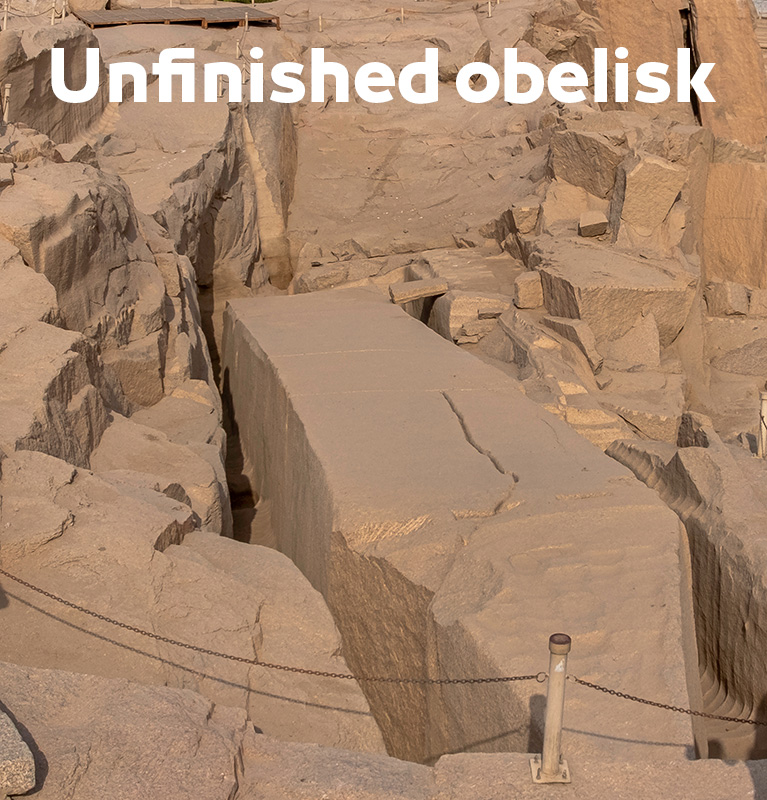
Unfinished obelisk
Pharaohs: Queen Hatshepsut.
Height: 42 m
Weight: KG
Original location: Aswan
Current location: Stone Quarries in Aswan.
- The unfinished obelisk was carved from stone rocks in the northern quarry in the area of the ancient city of Aswan in southern Egypt, but due to a crack and break in the middle of the obelisk, the carving stopped.
- Inscriptions were drawn on the walls of the Mortuary Temple of Hatshepsut in Deir El Bahari in Luxor explaining how the ancient Egyptians used to carve obelisks from granite and quarries and transport them on wooden boards in the Nile River to reach their place in the funerary temples to know more about Sculpture in Ancient Egypt and Architecture in ancient Egypt.
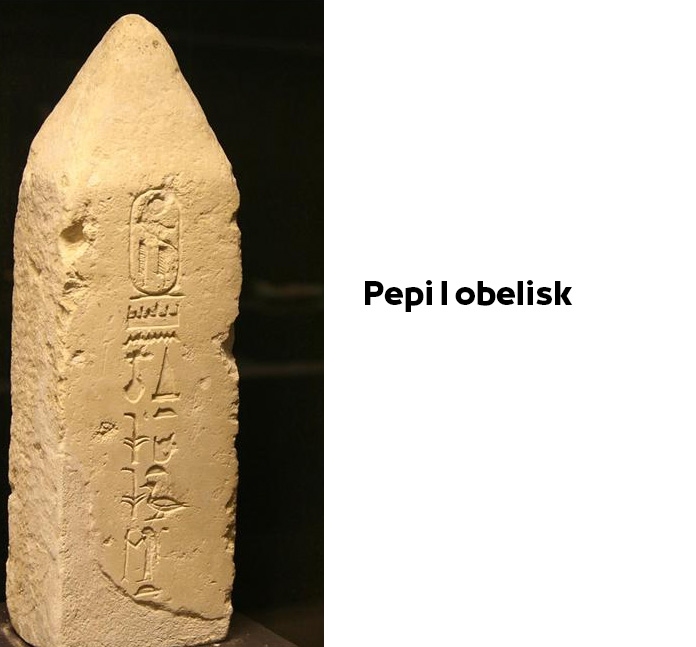
Pepi I obelisk
Pharaohs: king Pepi I Meryre – Sixth Dynasty of Egypt.
Height: 1 m
Weight: KG
Original location: Saqqara.
Current location: Imhotep Museum in Saqqara.
- The obelisk was dug and carved during the era of King Pepi I, the most famous king of the dynasty, with the completion of the steps to prepare the obelisk from its area in the rock quarry in the West Bank, West on the Nile River in the city of Aswan, work began on engraving and decorating the four sides of the obelisk, but it was not completed and work on it was stopped upon the death of King Pepi I.
- Texts in the ancient Egyptian language were discovered “among the Pyramid Texts of the funerary pyramids.” There are obelisks bearing the name of King Pepi I that were built and installed in the city “Heliopolis”.

Pepi II obelisk
Pharaohs: King Pepi II.
Height: 1 m
Weight: KG
Original location: Saqqara.
Current Obelisks location: Imhotep Museum in Saqqara.
- Texts and inscriptions attributed to Al-Hakim Sabni, “the ruler of the Lower Egypt region,” were discovered on the walls of the rocks in Aswan’s quarries.
- Two obelisks were prepared and transported from Aswan to the city “Heliopolis “It bears the name of King Pepi II, the most famous king of the Sixth Dynasty of Egypt.

King Teti Obelisk
Pharaohs: king Teti.
Height: 1 m
Weight: KG
Original location: Heliopolis.
Current location: open-air museum, Heliopolis.
The Obelisk of King Teti is considered one of the oldest Pharaonic obelisks, with a four-sided geometric design and a pointed pyramidal head, which was built in the City of the Sun “Heliopolis”.
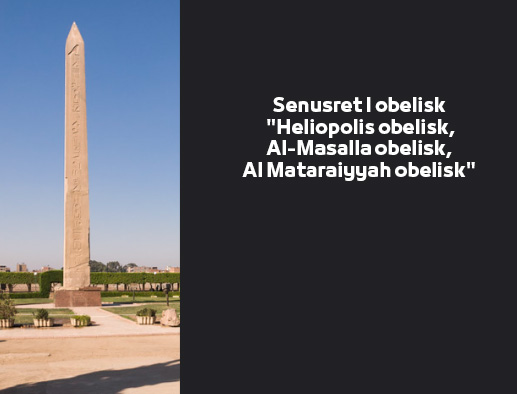
Senusret I obelisk “Heliopolis obelisk, Al-Masalla obelisk, Al Mataraiyyah obelisk”
Pharaohs: King Senusret I – Twelfth Dynasty of Egypt – Middle Kingdom of Egypt.
Height: 21 m.
Weight: 121 tons.
Original location: Heliopolis.
Current Obelisks location: Al-Matariyyah district in Heliopolis, Cairo.
- Two obelisks bearing the name of King Senusret I, “the most famous king of the family from the Middle Kingdom period,” were cut and prepared from pink granite stones from the rock quarries of Aswan. They were then transported and installed in front of the temples of the sun in Heliopolis.
- The other obelisk was seized and the name and titles of King Senusret I were removed from King Ramesses II, the most famous king of the nineteenth Egyptian dynasty of the New Kingdom, and it was discovered in the ancient city of Tanis.
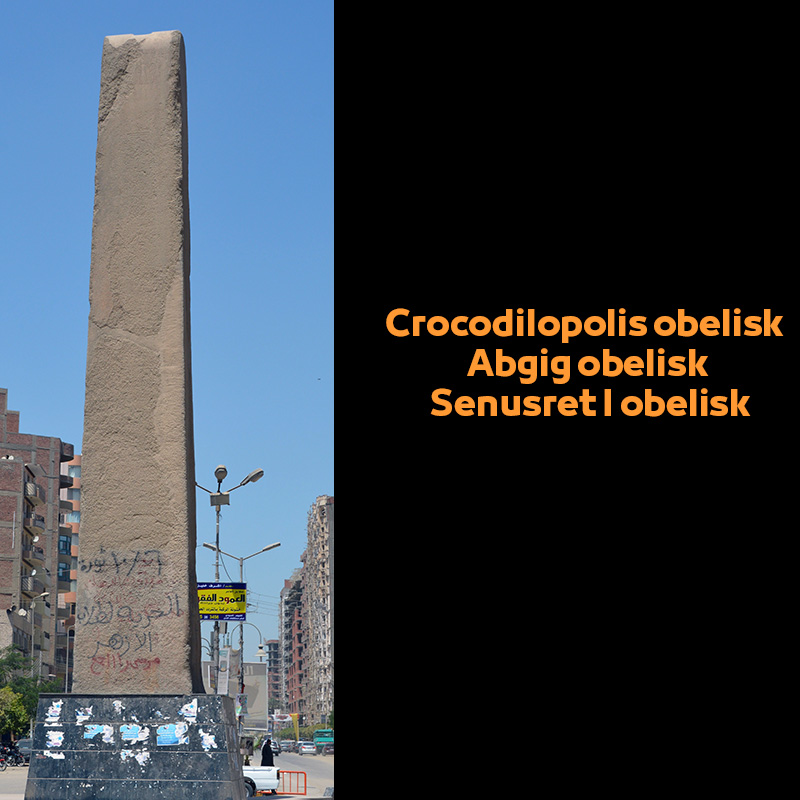
Crocodilopolis obelisk “Abgig obelisk, Senusret I obelisk”
Pharaohs: King Senusret I.
Height: 12.70 m.
Weight: tons.
Original location: Abgig, Faiyum.
Current location: Obelisk of Senusret I in Fayoum “Medinet el-Fayoum”.

Thutmose I obelisk
Pharaohs: King Thutmose I.
Height: 21 m.
Weight: 143 tons.
Original location: Karnak temple.
Current location: Karnak temple in Luxor.
- Two obelisks bearing the name of King Thutmose I, the most famous king of the Eighteenth Dynasty of Egypt, were built and equipped, and they were installed in the courtyard between the third and fourth pylons in the Karnak temple complex in the city of Thebes (Luxor).
- The obelisk of King Thutmose I was cut from red granite stones
- There is only one obelisk in the Karnak Temple, and the other was moved to another place.
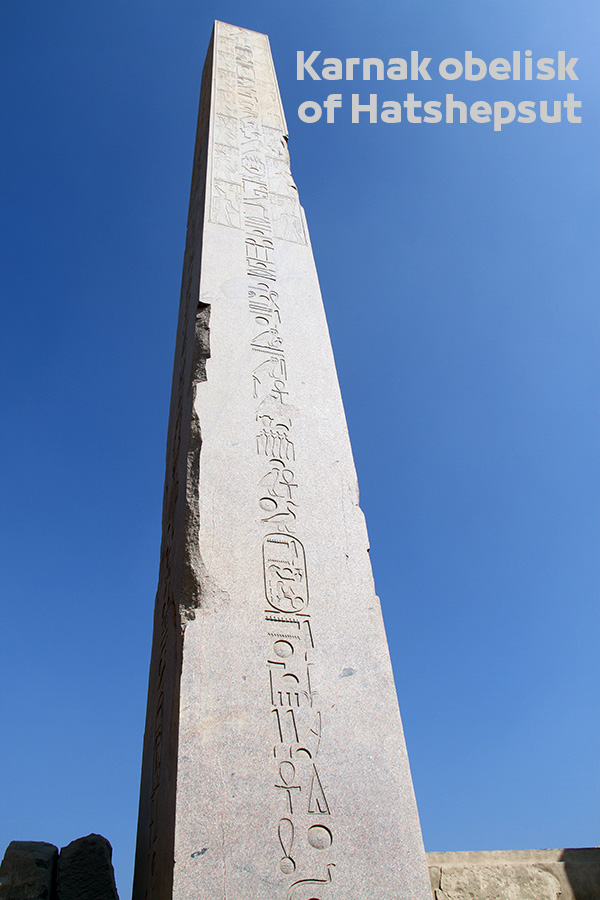
Karnak obelisk of Hatshepsut
Pharaohs: Queen Hatshepsut
Height: 30 m.
Weight: 323 tons.
Original location: Karnak Temple.
Current location: Karnak Temple in Luxor.
- The Obelisk of Queen Hatshepsut is distinguished by its towering height, reaching 30 meters in length and weighing 323 tons, in addition to the quality of the inscriptions and sculptures on the sides of the obelisk with high precision.
- Four obelisks bearing the name of Queen Hatshepsut, the most famous Pharaonic queen of Egypt throughout history, were built, cut and installed.

Luxor obelisk
Pharaohs: King Ramses II – Nineteenth Dynasty of Egypt.
Height: 25 m.
Weight: tons.
Original location: Luxor Temple.
Current Obelisks location: Luxor Temple in Luxor.
- An obelisk in Montazah Square in Cairo Governorate.
- Small obelisks displayed in the Egyptian Museum in Tahrir.
- Two obelisks in Luxor Temple, one obelisk currently exists as it is, and another obelisk was moved to Place de la Concorde in Paris, France, where it was carved from red granite from Aswan quarries
- 4 Pharaonic obelisks were built and installed in the city Heliopolis It bears the name of King Ramesses II, but it was completely transferred to Italy during the period of the rule of the Roman kings the era of the Roman Kingdom, there are now 3 obelisks in Rome’s city square and one in Florence’s city square.
- 23 Pharaonic obelisks were discovered in the ancient city of Tanis in the Delta, engraved with the name and titles of King Ramesses II. “There are theories that confirm that the names and titles of kings from previous eras of King Ramesses II were removed and his name was added to it.”
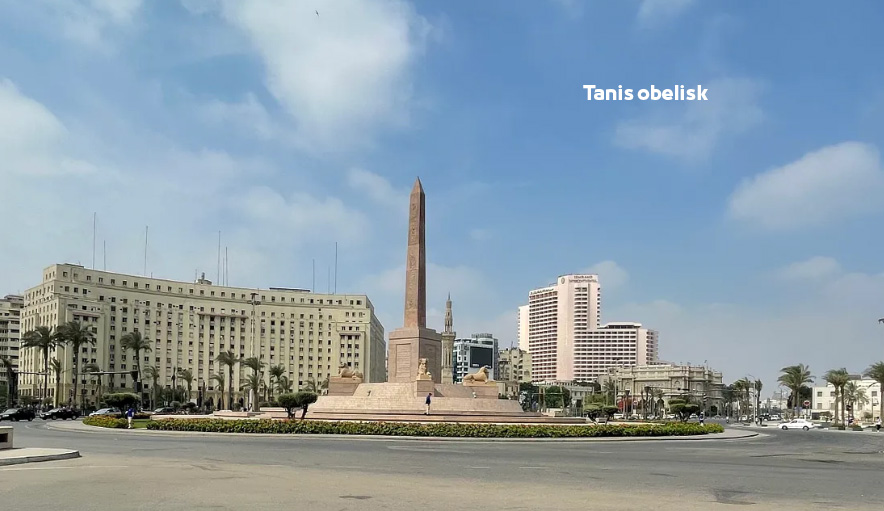
Tanis obelisk
Pharaohs: King Ramesses II.
Height: 17 m.
Weight: tons.
Original location: Tanis.
Current location: Tahrir Square obelisk in Giza, Cairo.
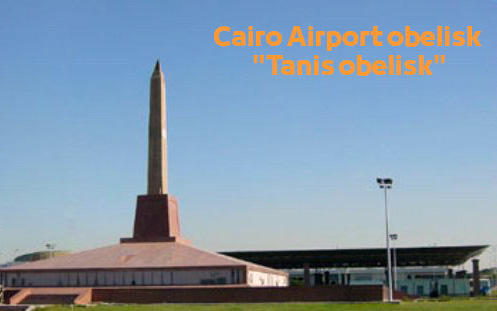
Cairo Airport obelisk “Tanis obelisk”
Pharaohs: King Ramesses II.
Height: 17 m.
Weight: tons.
Original location: Tanis.
Current location: Cairo International Airport in Cairo.
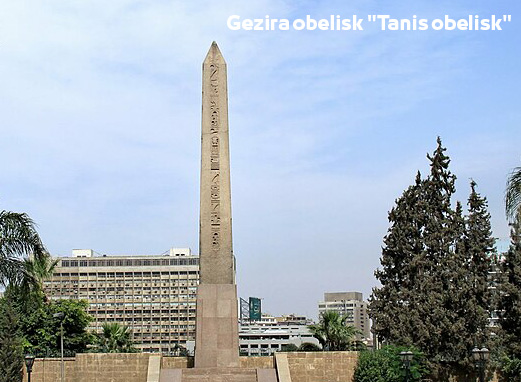
Gezira obelisk “Tanis obelisk”
Pharaohs: King Ramesses II.
Height: 13.5 m.
Weight: tons.
Original location: Tanis.
Current location: Gezira Island in Cairo.

Abu Simbel obelisks “Ramesses II obelisk”
Pharaohs: King Ramesses II.
Height: 3 m.
Weight: tons.
Original location: Temple of Abu Simbel in Aswan.
Current location: Nubian Museum in Aswan.
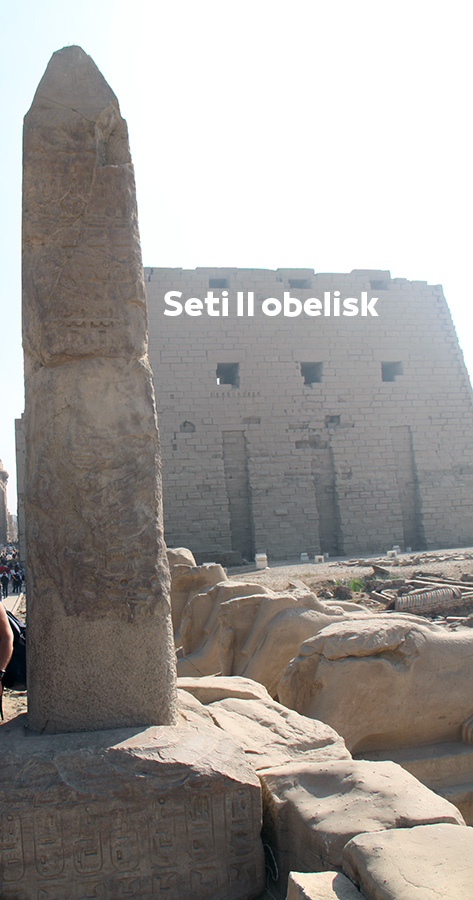
Seti II obelisk
Pharaohs: King Seti II.
Height: 1 m.
Weight: tons.
Original location: Karnak temple.
Current Obelisks location: Karnak temple in Luxor.
- There is only a two-sided obelisk in front of the Karnak Temple Complex in Luxor.
- It was carved from quartz stone and bears the names, titles, and victories of King Seti II.
Obelisk of King Ramesses IV
The obelisk of King Ramesses IV, the most famous king of the Twentieth Egyptian Dynasty (The Ramesside Period), was cut and carved from quartz metal, but over time it collapsed and only the stone base remained of the obelisk.
- Obelisk of King Ptolemy III
- Obelisk of King Domitian
- Obelisk of Emperor Hadrian
- Obelisks of King Merneptah
- Obelisk of King Amenhotep III
- Obelisk of King Akhenaten
- Obelisk of King Horemheb
- Obelisk of King Userkaf
- Obelisk of King Neuserre
Which countries have Egyptian obelisks?
What are the Pharaonic obelisks outside Egypt? What other countries have real Egyptian obelisks?
There are about 17 Pharaonic obelisks displayed outside the geographical borders of Egypt, displayed in squares in European and American cities around the world. Many of them were produced legally through gifts, while others were produced illegally and smuggled across the sea.
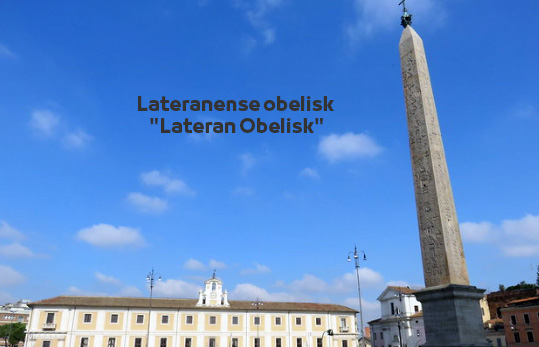
Lateranense obelisk “Lateran Obelisk”
Pharaohs: King Thutmose III and King Thutmose IV
Height: 32 m.
Weight: 455 tons.
Original location: Karnak Temple in Luxor
Current Obelisks location: Piazza di San Giovanni “Lateran Palace” in Rome, Italy.
- where it stood in the front courtyard of the Karnak Temple Complex in Luxor.
- The obelisk was cut and carved from red granite stones.
- Two obelisks for King Thutmose IV were cut and installed on Philae Island in Aswan near the funerary temples.
- The obelisk of King Thutmose IV in front of the third pillar in the Karnak temple complex in Luxor is 20 meters long and weighs 143 tons. It was carved from red granite.

Istanbul obelisk “Obelisk of Theodosius”
Pharaohs: King Thutmose III.
Height: 19 m.
Weight: 800 tons.
Original location: Karnak Temple.
Current location: Sultanahmet Square, Constantinople, Istanbul, Turkey.
- It dates back to the reign of King Thutmose III and was located in front of the seventh pylon in the Karnak Temple in Thebes (Luxor), southern Egypt.
- Its most important feature is the inscriptions and decorations on the sides of the obelisk showing scenes of King Thutmose III worshiping the god Amun Ra, and the other side shows scenes telling of the king’s victories over the enemies in the Nahrina region in Syria.
- The Pharaonic obelisk was broken while being transported from its ancient location to its current location in the square in Istanbul, Turkey.
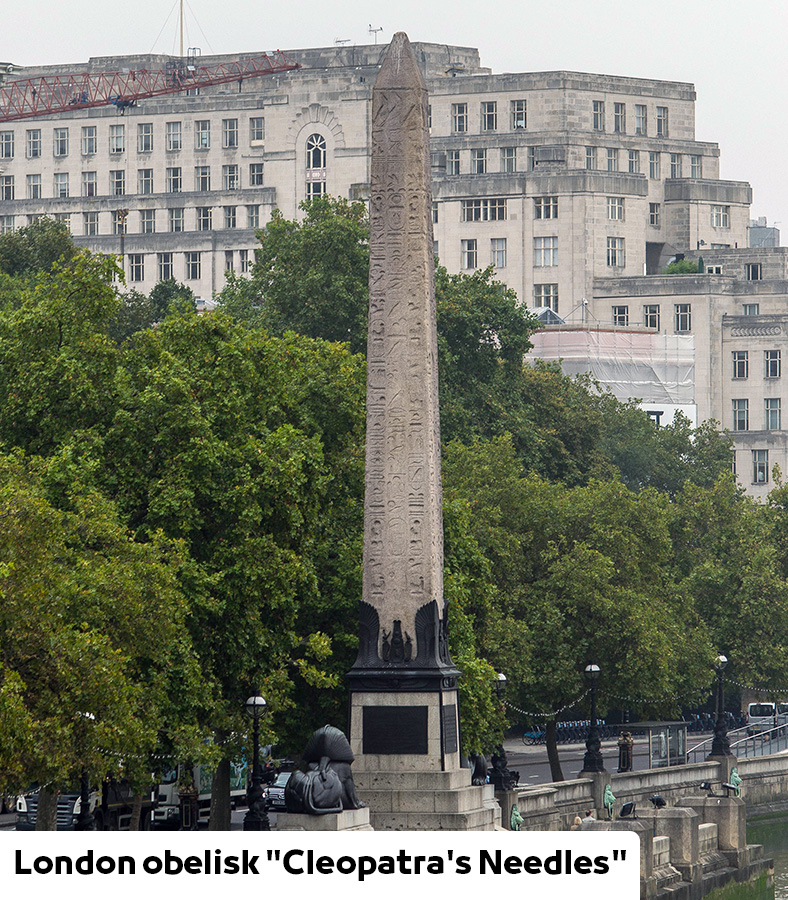
London obelisk “Cleopatra’s Needles”
Pharaohs: King Thutmose III.
Height: 21 m.
Weight: 178 tons.
Original location: Heliopolis.
Current location: Victoria Embankment in London, United Kingdom.
- It dates back to the reign of the warrior King Thutmose III and was located in front of the Temple of the Sun in the city Heliopolis Northern Egypt.
- The obelisk was carved from red granite
- It left Egypt legally, as Khedive Abbas gave it to Queen Victoria in 1877 AD.
- King Tuthmosis III was interested in developing the arts of sculpture and architecture in his era. Seven obelisks were cut and installed in the Karnak temple complex in Luxor, southern Egypt, and two obelisks in front of the Sun Temples in Heliopolis “Northern Egypt”, incomplete obelisk bearing the name of King Thutmose III remains in the rock quarries in Aswan.
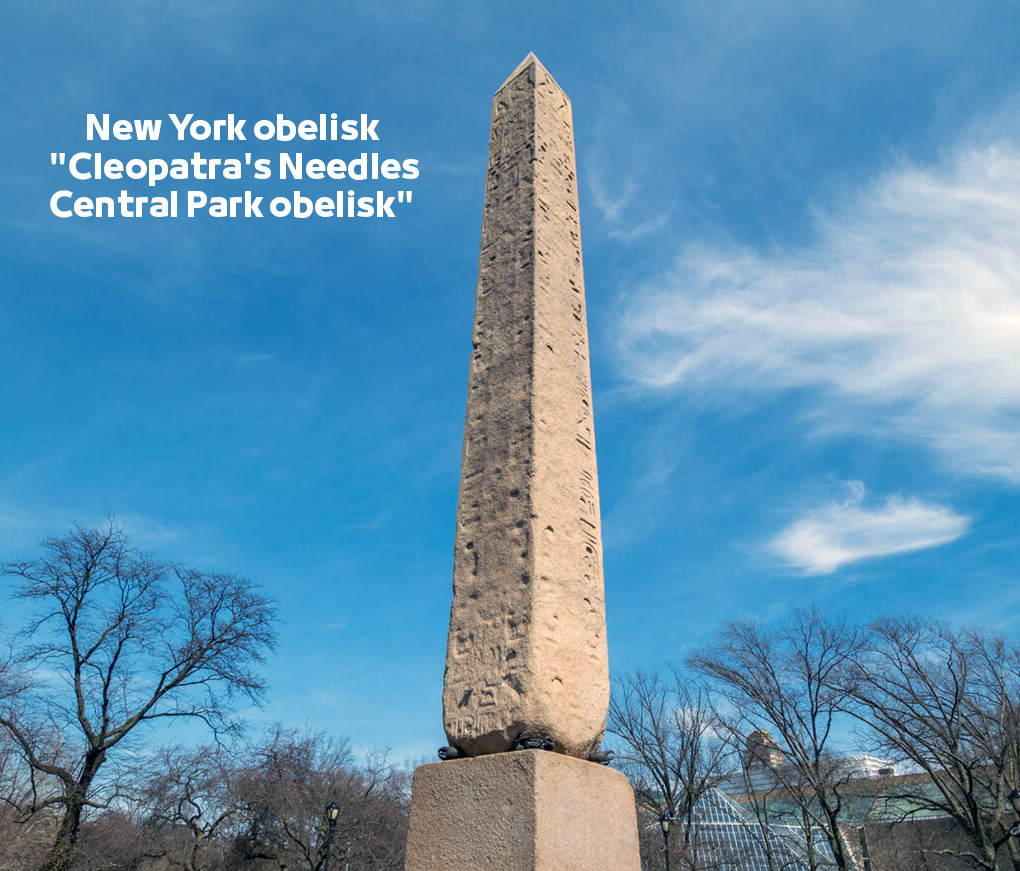
New York obelisk “Cleopatra’s Needles, Central Park obelisk”
Pharaohs: King Thutmose III.
Height: 21 m.
Weight: 193 tons.
Original location: Alexandria.
Current Obelisks location: Central Park in New York, United States.
- The obelisk was built during the reign of Thutmose III and was in front of the Temple of the Sun in the City of the Sun “Heliopolis”.
- King Augustus moved the obelisk from its place to the city of Alexandria, and then Khedive Ismail presented it to the President of the United States of America in 1869 AD as a “memorial gift during the opening of the Suez Canal.”
- The obelisk was carved from granite stones, features inscriptions in Greek and Latin, explains how King Augustus moved the obelisk and how it still is It retains the quality of the sculpture and engraving on the four sides and the solidity of the bronze metal underneath.
- The obelisk was moved from Egypt to a square behind The Metropolitan Museum of Art in 1881 AD, then it was moved to Central Park Square.
- The archaeological transport process took 15 months to install.

Macuteo obelisk “Pantheon obelisk, Rotonda obelisk”
Pharaohs: King Ramesses II.
Height: 15 m.
Weight: tons.
Original location: Heliopolis.
Current location: Piazza della Rotonda in Rome, Italy.
- The obelisk was built during the reign of King Ramesses II and was located in front of the Temple of the Sun in the city Heliopolis.
- The Pharaonic obelisk was carved from granite the red.
- The obelisk contains a commemorative dedication from the Italian government to the researcher and explorer Chiriacometti.

Flaminio Obelisk “Popolo obelisk, Flaminian Obelisk”
Pharaohs: King Seti I, King Ramesses II.
Height: 32 m.
Weight: 235tons.
Original location: Heliopolis.
Current location: Piazza del Popolo in Rome, Italy.
- The obelisk was carved during the era of King Seti I only, but work on cutting and decorating it stopped after his death, until his son, King Ramesses II, came and completely completed it and installed it in front of the Temple of the Sun in Heliopolis.
- The obelisk was cut from pink granite.
- The obelisk was moved from Egypt to Rome by Emperor Augustus to Maximus Square, then it was moved again in 1598 AD to Piazza del Popolo in the Italian city of Rome during the Emperor’s rule. Pope V and Pope VI.
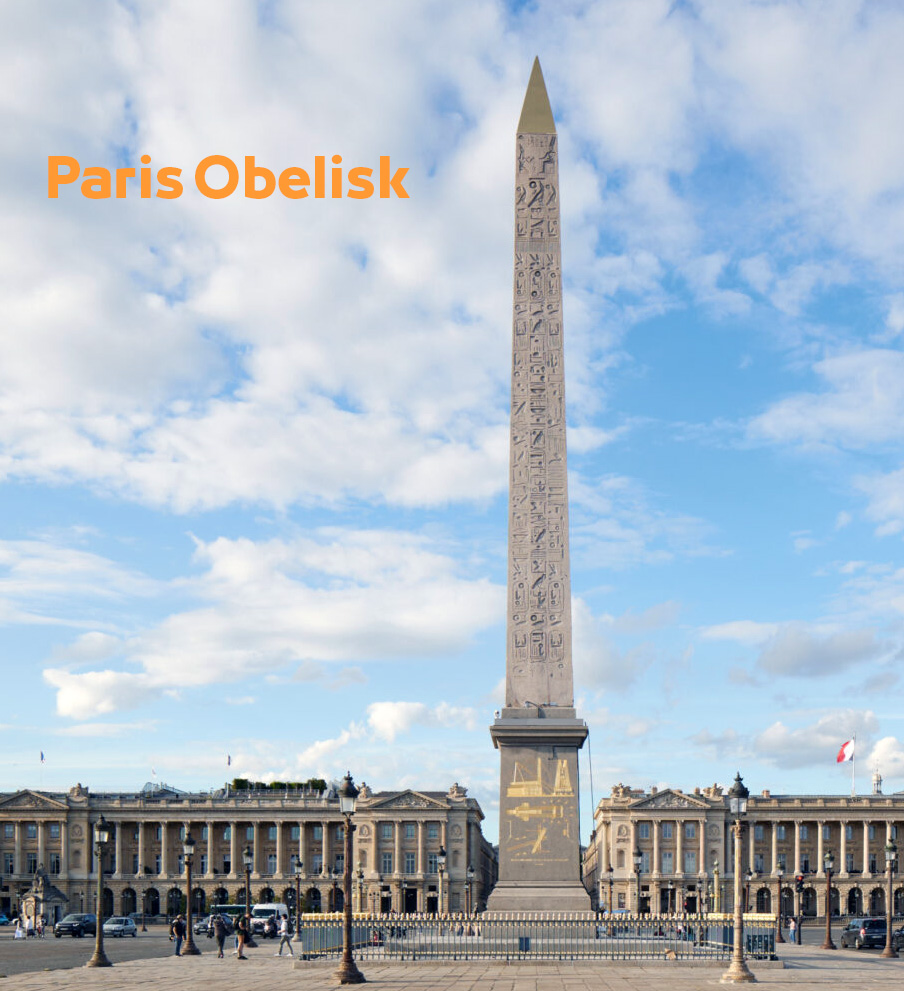
Paris Obelisk
Pharaohs: King Ramesses II.
Height: 22 m.
Weight: 227 tons.
Original Obelisks location: Luxor Temple in Luxor.
Current location: Place de la Concorde in Paris, France.
- The obelisk was carved from red granite from Aswan quarries.
- The obelisk was erected in front of the Luxor Temple during the era of King Ramesses II.
- The obelisk was legally transferred from Egypt to France after Muhammad Ali Pasha gifted it to Louis-Philippe I, “King of France,” in 1831 AD.
- The obelisk is now on display in Place de la Concorde in Paris, France.
- The top of the pointed pyramid of the Pharaonic Obelisk was covered with pure gold in 1998 AD by the French government for celebrations of the Men’s Football World Cup.

Vatican Obelisk “Caligula’s obelisk”
Pharaohs: Imperator Augustus.
Height: 25 m.
Weight: 323 tons.
Original location: Alexandria.
Current location: St. Peter’s Square in Vatican City, Italy.
- The obelisk was carved from red granite and is 25 meters long, but it does not contain inscriptions or decoration on the four sides.
- The obelisk was carved, cut, and installed in the city of Alexandria during the reign of Emperor Augustus, the most famous ruler of the Roman Kingdom.
- The obelisk was moved from Egypt to Vatican Square in 37 AD.

Solare obelisk “Campense obelisk, Montecitorio obelisk”
Pharaohs: king Psamtik II – Twenty-Sixth Dynasty of Egypt – Late Period.
Height: 22 m.
Weight: tons.
Original location: Heliopolis.
Current location: Piazza di Montecitorio in Rome, Italy.

Philae obelisk
Pharaohs: King Ptolemy IX Soter – Ptolemaic Kingdom.
Height: 6.70 m.
Weight: tons.
Original location: Philae in Aswan “Temple of Isis Near Old Cataract“.
Current location: Kingston Lacy, Dorset, United Kingdom.
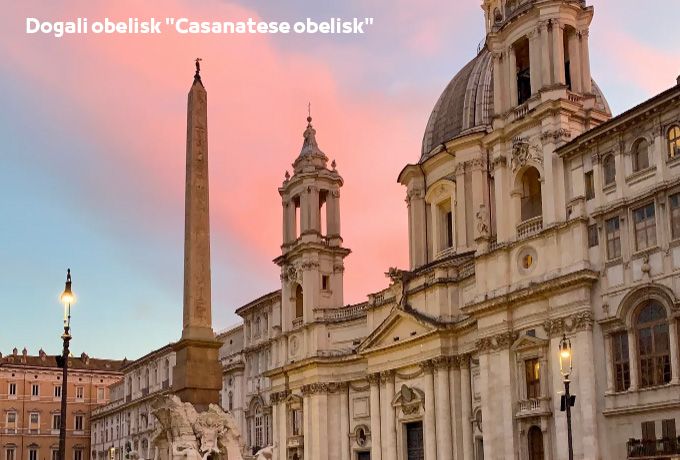
Boboli Obelisk “Dogali obelisk, Casanatese obelisk, “
Pharaohs: King Ramesses II.
Height: 6.34 m.
Weight: tons.
Original location: Heliopolis.
Current Obelisks location: Boboli Gardens, Florence, Via della Terme di Diocleziano, Rome, Italy.

Dogali obelisk “Casanatese obelisk”
Pharaohs: King Ramesses II.
Height: 2 m.
Weight: tons.
Original location: Heliopolis.
Current location: Baths of Diocletian in Rome, Italy.

Urbino obelisk “Apries obelisk, Elephant Obelisk, Minerveo obelisk”
Pharaohs: king Apries.
Height: 6 m.
Weight: tons.
Original location: Sais.
Current location: Piazza della Minerva “Urbino” in Rome, Italy.

Albani obelisk “Urbino obelisk”
Pharaohs: King Apries.
Height: 3 m.
Weight: tons.
Original location: Sais.
Current location: Ducal Palace in Urbino, Italy.
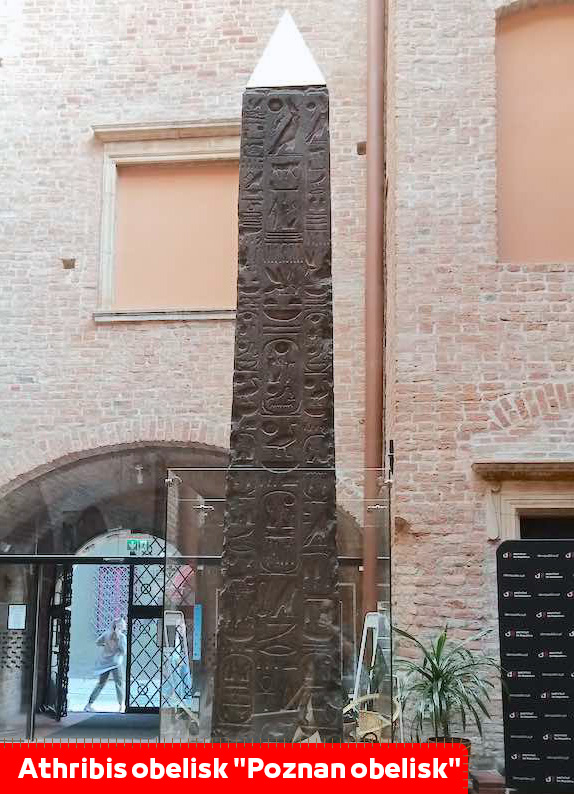
Athribis obelisk “Poznan obelisk”
Pharaohs: King Ramesses II.
Height: 3 m.
Weight: tons.
Original location: Athribis.
Current Obelisks location: Poznań Archaeological Museum in Poznan, Poland.
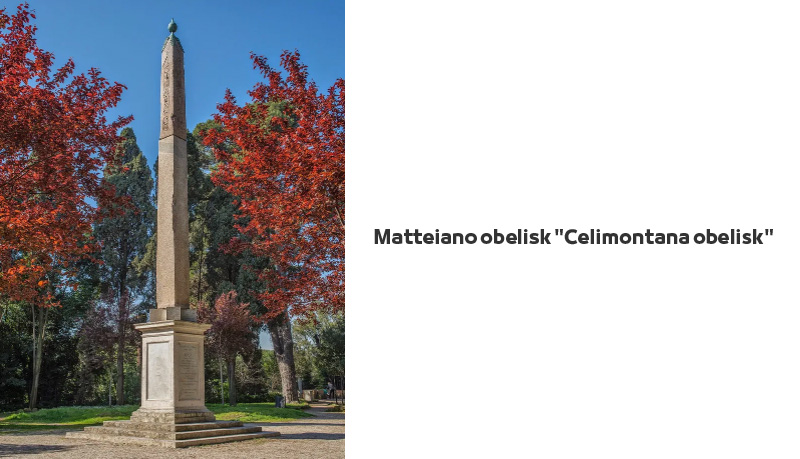
Matteiano obelisk “Celimontana obelisk”
Pharaohs: King Ramesses II.
Height: 2.7 m.
Weight: tons.
Original location: Heliopolis.
Current location: Villa Celimontana in Rome, Italy.

Durham obelisk “Amenhotep II obelisk”
Pharaohs: King Amenhotep II.
Height: 2 m.
Weight: tons.
Original location: Elephantine Island in Aswan.
Current location: Oriental Museum, University of Durham in Durham, United Kingdom.
Two obelisks bearing the name of King Amenhotep II, the most famous king of the dynasty, were cut and installed in front of the sun temples in the city “Heliopolis”.

Hermopolis obelisk “Obelisks of Nectanebo II”
Pharaohs: King Nectanebo II – Thirtieth Dynasty of Egypt.
Height: 1 m.
Weight: tons.
Original location: Hermopolis.
Current Obelisks location: The British Museum in London, United Kingdom .
Hurghada Lovers best Tour Operator to provide daily tours to visit the Tourist attractions of Luxor by Hurghada to Luxor Day Trips and Cairo by Hurghada to Pyramids Day Trips to discover the secrets Obelisks of Pharaohs. Book online when you come to Hurghada, El Gouna, Sahl Hashish, Makadi Bay, Soma Bay.
